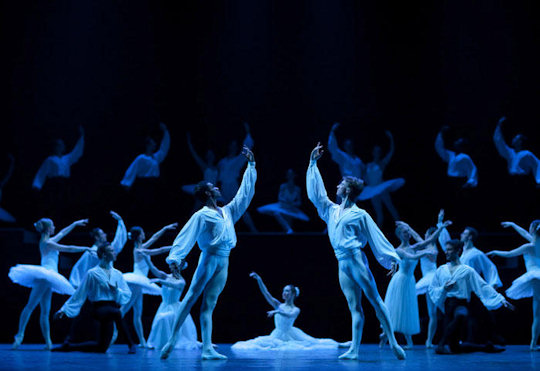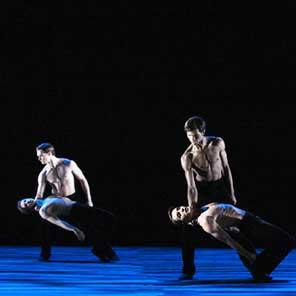Other Links
Editorial Board
- UK Editors
- Roger Jones and John Quinn
Editors for The Americas - Bruce Hodges and Jonathan Spencer Jones
European Editors - Bettina Mara and Jens F Laurson
Consulting Editor - Bill Kenny
Assistant Webmaster -Stan Metzger
Founder - Len Mullenger
Google Site Search
SEEN AND HEARD UK BALLET REVIEW

Suite en Blanc
Throughout my life if I have occasionally have been asked if I could be
granted a 'gift' for one day what would I choose; unhesitatingly I have
always replied that I would want to be a ballet dancer: of course this
year although the hugely successful Black Swan film and the
BBC4 programme Agony & Ecstasy: A Year with English National Ballet
has stripped bare - in more ways than one - the world of ballet and
revealed the real agony and hard-work behind the glamour. Truth be told
I always knew what it was really like but many stage-struck mothers with
ambitious young children may not have realised what they were getting
themselves into until now. The film we can dismiss as fiction but on
BBC4 we are getting a truer insight into the workings of a ballet
company - albeit a heavily edited version - so in the first two
programmes we have seen the petulant antics of the bullying
stereotypical choreographer pushing dancers into performing steps he
could never manage in his prime and then a company pulling together to
put on a show despite shortage of personnel and finances. Of course it
makes good TV to see the dancers enjoying their alcohol and then
bemoaning when they are easily injured or fatigued. This puts me in mind
of Premier League footballers - though a privileged few of them earn
more in one day than the lowest ranked dancer earns in a year.
The best way to determine the 'health' of a ballet company is not all
the tantrums and travails backstage but what happens on stage. The
opening night of this short Black & White run showed they are
in excellent shape with a number of talented dancers, if perhaps too few
genuine 'stars'. I first encountered ENB - or London Festival Ballet -
some thirty-five years ago when Nureyev staged Sleeping Beauty
for them - it remains perhaps the most beautiful and atmospheric
production of this ballet I have ever seen. Nureyev revolutionised the
role of the male dancer who previously was just basically there to hold
the ballerina securely aloft or count correctly during supported
pirouettes. The men of the ENB were very important throughout all the
choreography on display during this mixed Black & White
programme and Nureyev would have been delighted.
In the first of two pieces created for the company by director Wayne
Eagling, Resolution is set to Mahler's Rückert-Lieder
(refinedly - if a little prosaically - sung by Elizabeth Sikora) and
takes it inspiration from Eagling's work with a muscular dystrophy
charity Duchenne. Resolution is moody, melancholic and
introspective that - too a point - fits Mahler's music well. There is
quite a bit here that is reminiscent of Béjart's 'Songs of a Wayfarer'
or Macmillan's 'Song of the Earth'. The choreography is imbued with
feeling and compassion - at one - with the music but not the meaning of
the songs. Liebst du um Schönheit is a love song crying out for
a poignant duet but does not get it. However - taking into account his
inspiration - the closing 'Ich bin der Welt abhanden gekommen' (I have
become lost to the world) is a triumph as there is a male trio, with one
(Van le Ngoc who had a busy evening as dancer and choreographer)
apparently ailing and weak, being nurtured and carried by the other two
in seeming despair. In its entirety is clearly a heart-felt piece and
everyone gives it their all. My only quibble was that the smoke, fairly
dark clothing and dull blue lighting (that became familiar during the
evening) was often not to the advantage of the dancers.
I guess thoughts of Black & White came before the success of
the recent ballet film and so the Black Swan pas de deux was
shoe-horned into the programme. ENB's principals Erina Takahashi and
Dmitri Gruzdyev lifted the sombre mood the opening Resolution
engendered with a few bravura minutes of technical brilliance. Gruzdyev
- who was a wonderful Romeo for the company when I saw him in January -
is still an excellent danseur noble and perfect partner: his
tours en l'air with secure soft landings and her basically
steady swift fouettés was - I repeat - a technical
ballet feast. However all sense of character was missing.

Men Y Men
Next was Wayne Eagling's Men Y Men that originated from the
need to give the male dancers something to do while the company recently
toured Giselle. It allows nine bare-chested men in black
trousers to show us what they are made of. Again there is a bare stage
and no plot: to Rachmaninov's piano preludes it has men partnering and
lifting one another in physical feats that often has more to do with the
acrobatics of Cirque du Soleil than ballet. Some of Eagling's
signature moves are seen here again such as a cascade of movement
through all the dancers that was particularly memorable in their final
series of fast virtuoso spins. The second Agony & Ecstasy
programme featured Max Westwell learning the role of Romeo and
his subsequent triumphant debut performance. It came as a surprise to
see he had not been promoted and was still a soloist. It became clear
why this was when he is seen dancing next to Vadim Muntagirov, the young
first soloist who featured in the first TV programme. Still barely in
his twenties, for Muntagirov each dance move was transmitted from his
feet upwards through his flexible body to the tips of his fingers; for
Westwell - good dancer as he is - not much happens above the waist.
After seeing ENB dancer Van Le Ngoc's new work Vue de l'autre I
overheard a - I assume - fellow critic say he would rather have pins put
into his eyes than sit through it again and how despairing love duets
were old hat. Truthfully it was a rather trite, tinkly, score by
Ludovico Einaudi but perhaps I was more open than some to it quaint,
romantic - albeit abstract - mood. Everyone was in leotards and Daria
Klimentová - clearly ENB's most musical ballerina - and Vadim Muntagirov
excelled in their opening pas de deux with a rose (that was an
unnecessary addition) as did Elena Glurdjidze and Arionel Vargas with
their chiffon scarf. It involves ten dancers and there is a silent
opening, exits, entrances, solos, off-centre balances, as well as, some
rather inelegant upside-down splayed lifts for the women. Everything is
resolved when Klimentová and Muntagirov return at the end for a spot-lit
happy ending.
The ballets of Serge Lifar are rarely performed in Britain despite the
significant part he played in twentieth-century dance. So an undoubted
highlight of the evening was Suite en Blanc, choreographed by
Serge Lifar in 1943 to music for the lost Lucien Petipa ballet
Namouna by the nineteenth-century composer Edouard Lalo. It has not
been danced by the company for 35 years and from the spectacular opening
image of the whole ensemble I knew we were in for a treat. It includes
(in order) a pas de trois, pas de cinq and pas de
deux and four major solos, as well as, making incredible technical
demands on all the dancers, including those in the corps de ballet.
It is undoubtedly strictly classical (with the emphasis on beats and
turns) but stylistically it represents Lifar's development of classical
choreography, famously with the pleasingly natural use of arms and his
'sixth position' (tight parallel feet, rather than turned out).
It is a tribute to ENB's strength in depth - and Maina Gielgud's
restaging - that it was performed with such appropriate technique and
also captured that distinctive style of Serge Lifar so well. There is a
long and rather unnecessary prelude - albeit quite well played by the
always competent ENB Orchestra under Gavin Sutherland - before the
curtain goes up and it was danced throughout with panache and incredible
élan. It was good to see some of the junior dancers outshining their
more established colleagues, most notably the exuberant Lauretta
Summerscales and Junor Souza in the Pas de Trois and the
stylish Shiori Kase in the Serenade. Kase reminds me of a young
Miyako Yoshida - from me there can be no higher praise. For the senior
principals Elena Glurdjidze let the side down a bit with a rather
hesitant 'Cigarette' solo but Dmitri Gruzdyev danced a rumbustious
Mazurka. One word for this performance of Suite en Blanc:
Incandescent.
Jim Pritchard
Pictures courtesy of English National Ballet
